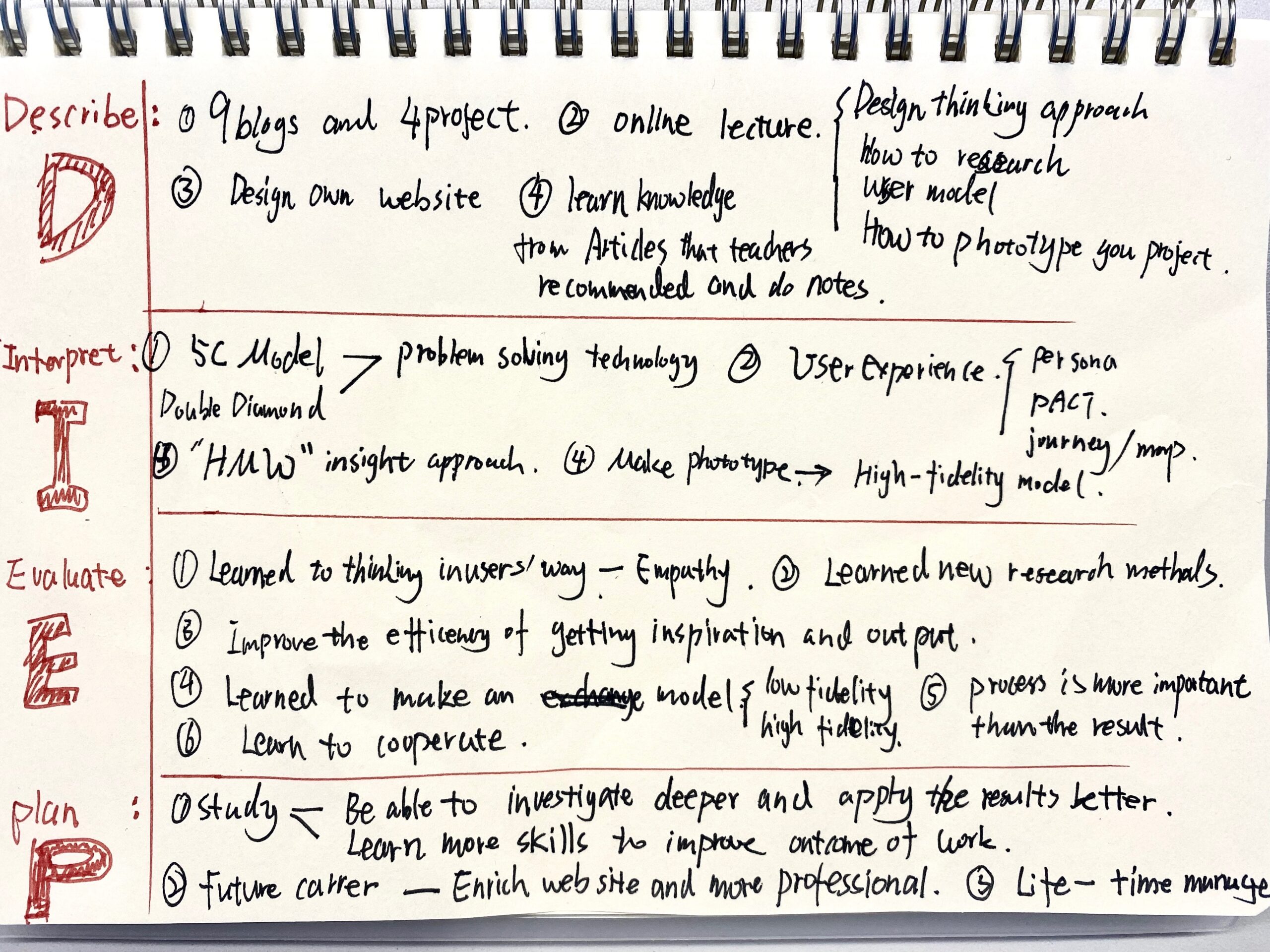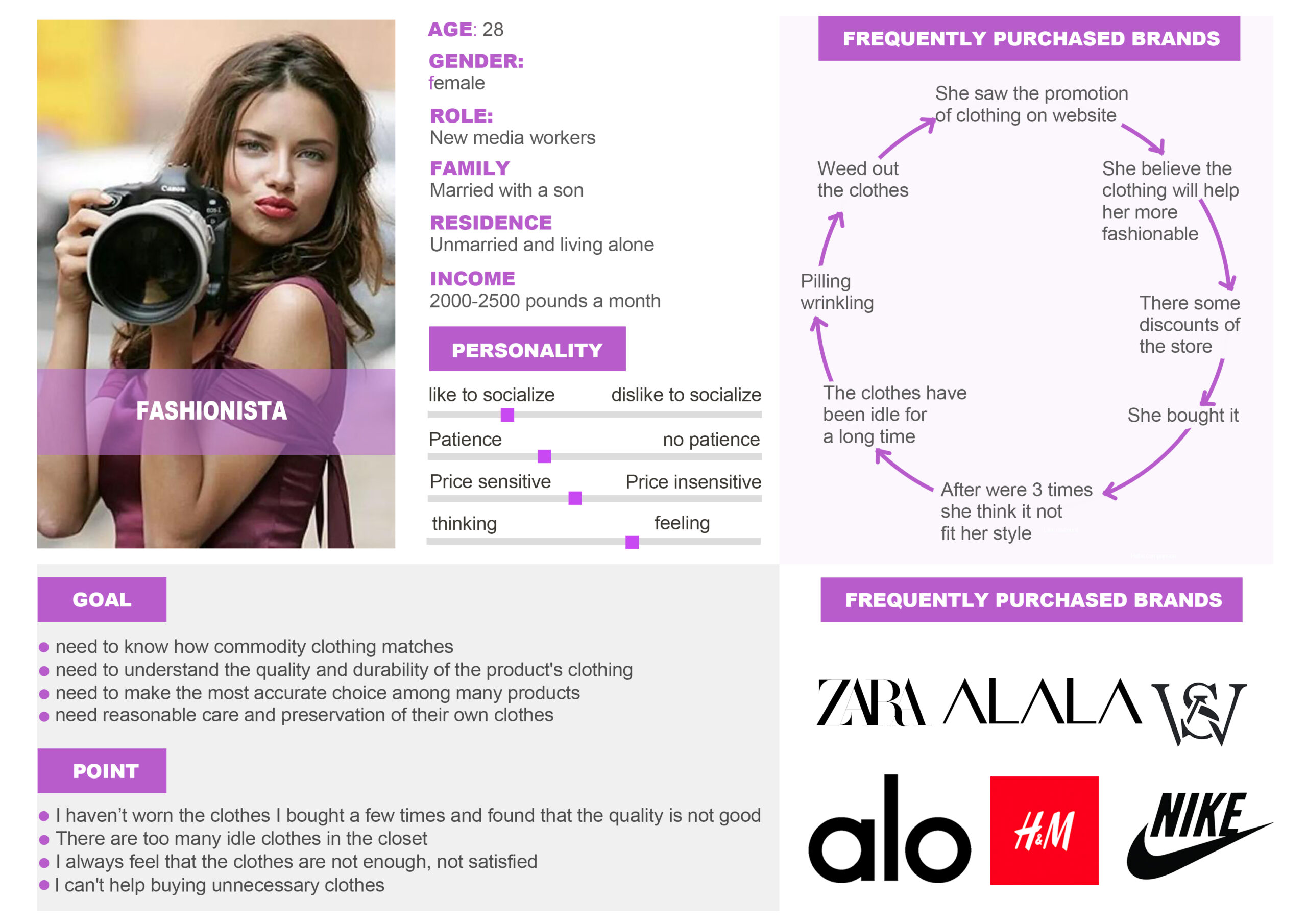Blog10:Reflective Report
introduction
As a designer in the design industry, we should not only focus on the results, but also the process of your creation and the way you observe and think, so as to make progress from constant reflection. In this paper, I will use DIEP (RMIT University, 2021) way to reflect and summarize my work and harvest in this period from the four levels of description, explanation, evaluation and planning.

My DIEP list
Description: “What did I do”
From the beginning of the school to the present, I have produced and submitted four works. The first two works focus on thinking and research, and the second two focus on innovation and practice. In the process of project creation, I have teachers’ design knowledge guidance, and feedback from teachers and classmates in class. Finally, I put my work on my personal website, and the teacher also professionally evaluates our website from an interactive perspective.
I write a blog every week, so far I have 10 articles. The content includes articles and lectures in the professional field of design. I have made a lot of study notes and sketch, as well as feedback on my own projects.
Interpret:”describe my learning”
When I first came into contact with the subject of interaction design, I was taught the design method of 5C model (Friis& Gelting, 2014), which taught me how to think and create works scientifically and logically: 1. Collecting information, any design is based on real life, we can make our works practical application in the later stage through a lot of background research and interviews; 2; 2. Understand that after information collection, we should abstract the information we get, analyze the data, find problems, find users’ needs and pain points, and make plans for future work; 3. Conceptualization: get keywords based on the data analyzed before, brainstorm these keywords, get inspiration, make clear what the project will do, and then imagine what it will look like. 4: Creation. In the creation time, we need to brainstorm, based on the previous work of product iteration and output.

5C model
I also learned how to build user models, including persona, empathy map, storyboard, user journey map, etc. The establishment of this model needs to be based on a large number of user research, such as questionnaire, telephone interview, tracking experience and so on. In the process of drawing this model, we need to understand and experience the user’s listening, thinking, speaking, behavior, etc. as much as possible, so as to achieve empathy with the user, find the user’s needs, and design the things that can let us design the user’s needs.

PACT of project 4
It’s a long time for designers to get inspiration, but “HMW” way of thinking makes me improve the efficiency of getting inspiration (Design Kit, 2021). By constantly asking myself “how can we… Solve a problem… In a certain way”, I come up with a wide range of ideas, then sift through the key information, narrow the scope, and finally decide the theme.
In the process of design output, I learned to make low-fidelity prototype models and high-fidelity iterative models. Low-fidelity model: I made the ipad paper film in Project 3. Unlike the electronic model, I must consider the movement effect of the page when making the paper film. It can show the user’s gesture operation, and it can be used for testing. It is easier to find the problems encountered by the user during operation. For Project 4, I used a high-fidelity prototype design. The high-fidelity layout and visual design are more detailed than the paper app model, which is closer to the real operating state of the user when using the product. It is a pity that it is difficult for me to achieve the effects I want in the visual effects of the user operation of the high-fidelity model, such as rich dynamic effects. I try to show it as much as possible by learning some software by myself. I used the Chinese app production software modao, and showed it through editing videos, but it still seems too simple. I still have some regrets about it.

Prototype modeling in project 3
Evaluate:“What I have learned”
First of all, I found a more scientific and suitable design thinking method. Before I went to graduate school in Southampton, I always thought that design is about discovering problems and then proceeding directly to the design process. I didn’t know that the whole process of design was divided into four steps such as the “5C model”. Indispensable. This design workflow model is also very useful for future work. It allows me to keep my thoughts in the process of doing projects without confusion, and the work steps are more organized.
Secondly, when creating projects 2-4, I learned how to analyze users; I learned how to make user modeling. This technology focuses on using one’s empathy ability to understand users, empathizing thinking and removing one’s own subjective assumptions so that one’s own design adheres to people-oriented and user-centered. When conducting research on users, my language organization skills and ability to capture users’ psychology have improved. I can easily find that when conducting user research on item 4, I am more aware of what I need and combine the previous user interview experience. , I can more skillfully guide users to express their true thoughts in detail. This progress is very important, and it can improve the efficiency of user research in future projects.
Finally, I realized the importance of cooperation. Before I proceeded to Project 4, I always thought that a designer must be independent enough to be good enough and able to think on his own without the help of others as much as possible, but I found that this inherent idea makes me Become closed, and did a lot of useless work when making works. Specifically, when I was working on Project 4, I initially wanted to design a label that could remind users how to take care of their clothes to prolong the use time of clothes and reduce the elimination rate of clothes to reduce excessive consumption. For this reason, I even did a lot of research, such as: which clothes are easy to deteriorate, and which parts of the clothes are easy to deteriorate. Finally, when I chatted with my classmates about my thoughts, my classmates told me that in fact, most clothes are labeled Nursing instructions, and she proved this fact to me, so I had to change my research direction. This matter made me understand that it is really important to listen to other people’s opinions, and it will really avoid some unnecessary useless work. Through the last lesson, I invited more than one person to test the prototype design of Project 4 “Minimalist Wardrobe App”. I accepted some of their opinions and the smoothness of my app operation has also improved.
Plan:”what will I do”
Through this semester of study, I found that in order to become a good designer, I must learn more skills, especially some software that can improve efficiency, because when I watch other people’s works, people with more software skills The presentation effects of their works are more vivid and real. I recently started to try to learn some software by myself to achieve certain presentation effects. Although it really slows down the work progress, I see that other students are excellent, and I must improve myself Skills.
In the future design practice, I need to improve my working time management ability. In my design practice, I am always prone to be delayed for a long time by some small things at work, such as how to use design tools, etc., but the important things are delayed at the end. The work habit that can not grasp the key points makes me always The work displayed is not good enough because the deadline is approaching. So I plan to do the important things first in the future project production process, and to do the unimportant things selectively, because I can’t solve it by myself and seek help from others and arrange the time reasonably.
Friis, SAK & Gelting, AKG., 2014. ‘The 5C Model’, Paper presented at DesignEd Asia Conference, Hong Kong 2014, 02/12/2014 – 03/12/2014.
Designkit.org. 2021. Design Kit. [online] Available at: <https://www.designkit.org/methods/create-insight-statements> [Accessed 17 May 2021].
Rmit.edu.au. (2021) RMIT University. [online] Available at: https://www.rmit.edu.au/ [Accessed 16 May 2021].